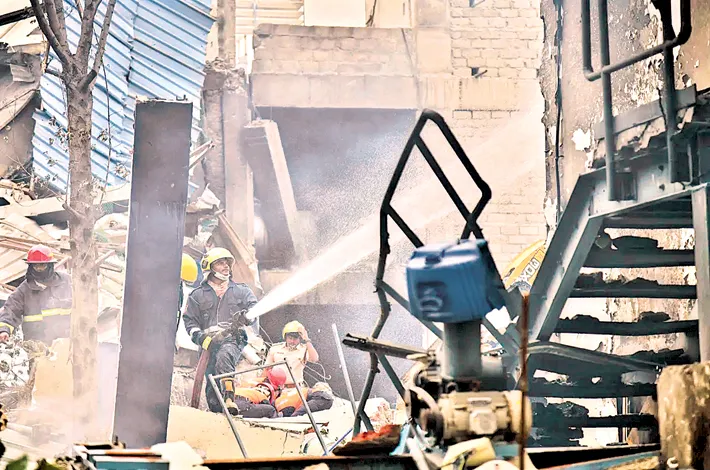Who’s Life is it anyway!
13-07-2025 12:00:00 AM

The Sigachi Industries Fire Exposes Systemic Apathy in Telangana
It was not an isolated incident. Over the past five years, Hyderabad’s industrial belts, particularly Pashamylaram and Patancheru, have seen at least 15 major fire accidents, resulting in over 50 deaths and 150 injuries
metro india news I hyderabad
On June 30, the industrial hub of Pashamylaram, roughly 50 kilometers from Hyderabad, became the epicenter of one of Telangana’s deadliest industrial disasters. A massive explosion at Sigachi Industries, a pharmaceutical company manufacturing microcrystalline cellulose, tore through a spray dryer unit, reducing a multi-story building to rubble and claiming 50 lives. Dozens more were injured, many critically, with burns and respiratory damage from inhaling toxic fumes.
The incident sent shockwaves through the twin cities of Hyderabad and Secunderabad, briefly dominating national headlines. Yet, 15 days later, the story has faded from public discourse, overshadowed by a chilling silence from both the government and Sigachi’s management.
No one has been held accountable, no arrests have been made, and no meaningful action has been taken to address the systemic failures that led to this preventable tragedy. The families of the victims, many of whom were migrant workers from states like Bihar, Uttar Pradesh, and Odisha, are left grappling with grief, unanswered questions, and a stark display of institutional apathy.
The human toll of the Sigachi explosion is staggering. Ganga Mukhya, a 35-year-old operator from Bihar, was the sole breadwinner for his wife, five children, and elderly parents. He worked grueling 12-hour shifts, including four hours of overtime, for a monthly wage of Rs. 18,000 after deductions. His wife, now widowed, told local reporters she was unaware if he had health insurance or if the family would receive support for medical bills or lost income.
Like many of the 143 workers present at the time of the blast, Ganga was a contract laborer, classified as “other than permanent” in Sigachi’s 2023-24 annual report, which noted that only 0.60% of the company’s revenue was allocated to worker welfare. The report also revealed that while employees had health and accident insurance, workers like Ganga were only covered for accidents, leaving their families vulnerable in the aftermath.
The explosion, suspected to be caused by a pressure buildup in the spray dryer exacerbated by fine chemical dust, was not an isolated incident. Over the past five years, Hyderabad’s industrial belts, particularly Pashamylaram and Patancheru, have seen at least 15 major fire accidents, resulting in over 50 deaths and 150 injuries. In December 2024, just six months before the Sigachi disaster, a flash fire at Srikar Pharmaceuticals in IDA Bollaram injured seven workers. Despite these recurring tragedies, inspections by the Telangana Factories Department have been woefully inadequate.
A December 2024 inspection of Sigachi’s Pashamylaram plant flagged multiple safety violations, including insufficient firefighting equipment and inadequate exit doors, yet officials rated conditions as “satisfactory” and required no additional permissions. The factory, operational since 1989, lacked a No Objection Certificate (NOC) from the Fire Department, a legal exemption exploited by thousands of similar facilities across Hyderabad. With only 27 factory inspectors overseeing Telangana’s 17,758 registered factories, oversight is a farce, and unregistered factories likely number in the thousands.
The government’s response has been equally lackluster. Telangana Chief Minister A. Revanth Reddy announced an ex gratia payment of Rs. 1 crore for the families of the deceased and Rs. 10 lakh for those incapacitated, alongside immediate relief of Rs. 1 lakh and Rs. 50,000 for the deceased and injured, respectively. Prime Minister Narendra Modi also pledged Rs. 2 lakh per deceased family and Rs. 50,000 for the injured from the Prime Minister’s National Relief Fund. While these financial measures offer temporary solace, they do little to address the root causes or deliver justice.
A five-member committee was formed to investigate the blast, but its findings remain pending, and no timeline for accountability has been established. Chief Minister Reddy’s visit to the site, 26 hours after the explosion, drew criticism for its delay, with opposition parties accusing the government of prioritizing optics over action. Posts on X echoed this sentiment, with one user.
The company announced a 90-day suspension of operations at the Pashamylaram plant, citing damage to equipment, and promised to cover medical expenses for the injured. Yet, its leadership has been conspicuously absent. Chief Minister Reddy publicly reprimanded the management for their silence, noting that the company’s founder and executive chairman failed to visit the victims’ families or the site in the immediate aftermath. A police case was registered against the management following a complaint by the son of a deceased worker, but no arrests or suspensions have followed.
The company’s claim of being “incident-free” for 35 years, as stated in its press releases, rings hollow in light of the December 2024 inspection report, which highlighted severe safety violations and a lack of fire safety mechanisms. Independent experts described the incident as “not just negligence, but a collapse of the regulatory mechanism meant to protect workers.” Sigachi’s stock plummeted nearly 24% in the days following the blast, reflecting investor fears of operational disruptions, but the human cost has yet to translate into corporate accountability.
The broader context of industrial safety in Telangana paints a grim picture. The state’s Ease of Doing Business (EoDB) reforms, intended to attract investment, have weakened compliance requirements, prioritizing profits over worker safety. Activists argue that the Factories Department, understaffed and overburdened, conducts inspections sporadically, if at all, with hazardous facilities like Sigachi’s rarely audited more than once a year.
The absence of stringent safety protocols, coupled with the flammable nature of microcrystalline cellulose, created a ticking time bomb. The National Disaster Management Authority’s investigation on July 8 confirmed that a dryer malfunction likely triggered the explosion, with failed sensors neglecting to sound alarms. Yet, the government’s response has been limited to promises of a “thorough investigation,” with no concrete steps to overhaul the regulatory framework or penalize those responsible.
For the families of the victims, the lack of accountability is a second wound. Many, like Ganga Mukhya’s wife, are left to navigate an uncertain future without their primary earners. The promised compensation, while substantial, cannot replace the lives lost or address the systemic failures that allowed this tragedy to occur.
The Sigachi explosion is a stark reminder of the human cost of apathy—by a government too slow to act, a company too quick to deflect, and officials too complacent to enforce. As Hyderabad’s industrial belts continue to grow, the question remains: how many more lives must be lost before accountability becomes more than a promise? Until then, the scars of June 30, 2025, will linger, not just on the bodies of the injured, but on the conscience of a system that failed to protect its most vulnerable.








